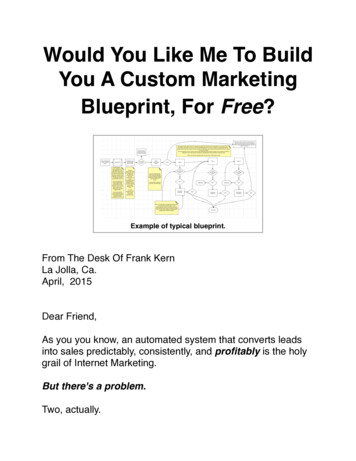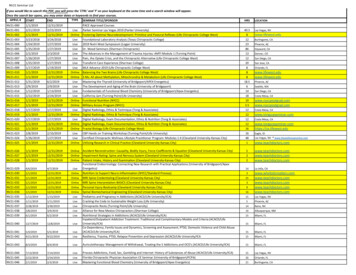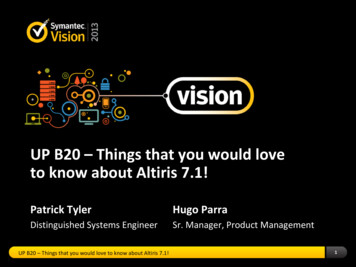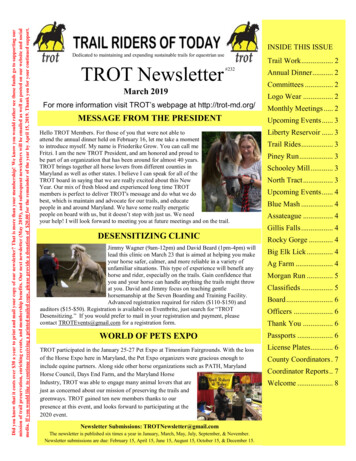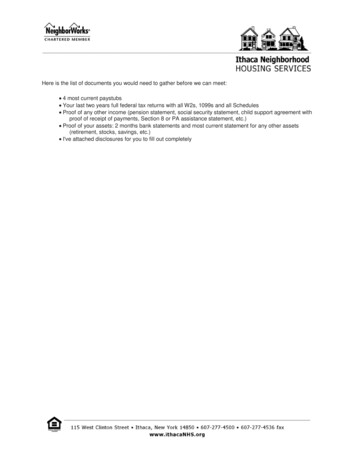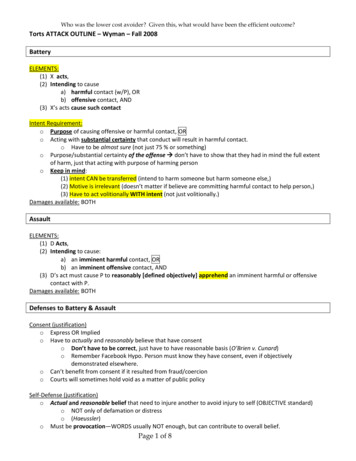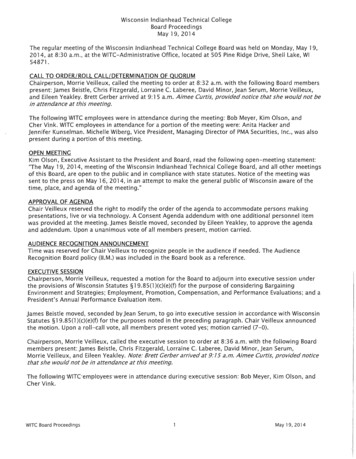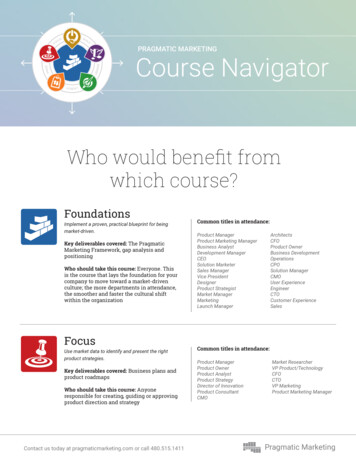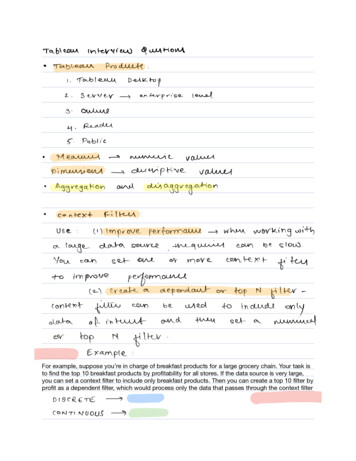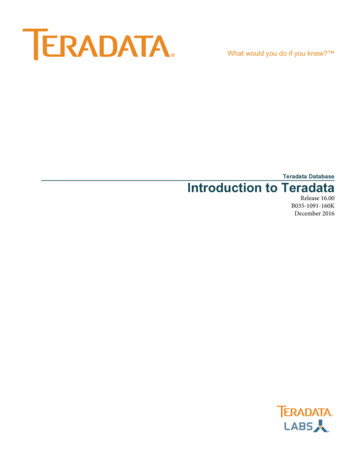
Transcription
What would you do if you knew? Teradata DatabaseIntroduction to TeradataRelease 16.00B035-1091-160KDecember 2016
The product or products described in this book are licensed products of Teradata Corporation or its affiliates.Teradata, Applications-Within, Aster, BYNET, Claraview, DecisionCast, Gridscale, MyCommerce, QueryGrid, SQL-MapReduce, TeradataDecision Experts, "Teradata Labs" logo, Teradata ServiceConnect, Teradata Source Experts, WebAnalyst, and Xkoto are trademarks or registeredtrademarks of Teradata Corporation or its affiliates in the United States and other countries.Adaptec and SCSISelect are trademarks or registered trademarks of Adaptec, Inc.Amazon Web Services, AWS, [any other AWS Marks used in such materials] are trademarks of Amazon.com, Inc. or its affiliates in the UnitedStates and/or other countries.AMD Opteron and Opteron are trademarks of Advanced Micro Devices, Inc.Apache, Apache Avro, Apache Hadoop, Apache Hive, Hadoop, and the yellow elephant logo are either registered trademarks or trademarks of theApache Software Foundation in the United States and/or other countries.Apple, Mac, and OS X all are registered trademarks of Apple Inc.Axeda is a registered trademark of Axeda Corporation. Axeda Agents, Axeda Applications, Axeda Policy Manager, Axeda Enterprise, Axeda Access,Axeda Software Management, Axeda Service, Axeda ServiceLink, and Firewall-Friendly are trademarks and Maximum Results and MaximumSupport are servicemarks of Axeda Corporation.CENTOS is a trademark of Red Hat, Inc., registered in the U.S. and other countries.Cloudera, CDH, [any other Cloudera Marks used in such materials] are trademarks or registered trademarks of Cloudera Inc. in the United States,and in jurisdictions throughout the world.Data Domain, EMC, PowerPath, SRDF, and Symmetrix are registered trademarks of EMC Corporation.GoldenGate is a trademark of Oracle.Hewlett-Packard and HP are registered trademarks of Hewlett-Packard Company.Hortonworks, the Hortonworks logo and other Hortonworks trademarks are trademarks of Hortonworks Inc. in the United States and othercountries.Intel, Pentium, and XEON are registered trademarks of Intel Corporation.IBM, CICS, RACF, Tivoli, and z/OS are registered trademarks of International Business Machines Corporation.Linux is a registered trademark of Linus Torvalds.LSI is a registered trademark of LSI Corporation.Microsoft, Active Directory, Windows, Windows NT, and Windows Server are registered trademarks of Microsoft Corporation in the United Statesand other countries.NetVault is a trademark or registered trademark of Dell Inc. in the United States and/or other countries.Novell and SUSE are registered trademarks of Novell, Inc., in the United States and other countries.Oracle, Java, and Solaris are registered trademarks of Oracle and/or its affiliates.QLogic and SANbox are trademarks or registered trademarks of QLogic Corporation.Quantum and the Quantum logo are trademarks of Quantum Corporation, registered in the U.S.A. and other countries.Red Hat is a trademark of Red Hat, Inc., registered in the U.S. and other countries. Used under license.SAP is the trademark or registered trademark of SAP AG in Germany and in several other countries.SAS and SAS/C are trademarks or registered trademarks of SAS Institute Inc.Simba, the Simba logo, SimbaEngine, SimbaEngine C/S, SimbaExpress and SimbaLib are registered trademarks of Simba Technologies Inc.SPARC is a registered trademark of SPARC International, Inc.Symantec, NetBackup, and VERITAS are trademarks or registered trademarks of Symantec Corporation or its affiliates in the United States andother countries.Unicode is a registered trademark of Unicode, Inc. in the United States and other countries.UNIX is a registered trademark of The Open Group in the United States and other countries.Other product and company names mentioned herein may be the trademarks of their respective owners.The information contained in this document is provided on an "as-is" basis, without warranty of any kind, either expressor implied, including the implied warranties of merchantability, fitness for a particular purpose, or non-infringement.Some jurisdictions do not allow the exclusion of implied warranties, so the above exclusion may not apply to you. In noevent will Teradata Corporation be liable for any indirect, direct, special, incidental, or consequential damages,including lost profits or lost savings, even if expressly advised of the possibility of such damages.The information contained in this document may contain references or cross-references to features, functions, products, or services that are notannounced or available in your country. Such references do not imply that Teradata Corporation intends to announce such features, functions,products, or services in your country. Please consult your local Teradata Corporation representative for those features, functions, products, orservices available in your country.Information contained in this document may contain technical inaccuracies or typographical errors. Information may be changed or updatedwithout notice. Teradata Corporation may also make improvements or changes in the products or services described in this information at any timewithout notice.To maintain the quality of our products and services, we would like your comments on the accuracy, clarity, organization, and value of thisdocument. Please e-mail: teradata-books@lists.teradata.comAny comments or materials (collectively referred to as "Feedback") sent to Teradata Corporation will be deemed non-confidential. TeradataCorporation will have no obligation of any kind with respect to Feedback and will be free to use, reproduce, disclose, exhibit, display, transform,create derivative works of, and distribute the Feedback and derivative works thereof without limitation on a royalty-free basis. Further, TeradataCorporation will be free to use any ideas, concepts, know-how, or techniques contained in such Feedback for any purpose whatsoever, includingdeveloping, manufacturing, or marketing products or services incorporating Feedback.Copyright 2000 - 2016 by Teradata. All Rights Reserved.
PrefacePurposeThis book provides an introduction to Teradata covering the following broad topics: The data warehouse and active TeradataThe relational model and Teradata Database architectureTeradata Database hardware and software architectureTeradata Database RASUI (reliability, availability, serviceability, usability, and installability)Communication between the client and Teradata DatabaseData definitions and data manipulation using SQLSQL application developmentData distribution and data access methodsConcurrent control and transaction recoveryThe Data DictionaryInternational character supportQuery and database analysis toolsDatabase security and system administrationManaging and monitoring Teradata DatabaseAudienceThis book is intended for users interested in a broad overview of Teradata. Such individuals may includedatabase users or administrators.Supported Software Releases and OperatingSystemsThis book supports Teradata Database 16.00.Teradata Database 16.00 is supported on: SUSE Linux Enterprise Server (SLES) 11 SP1 SUSE Linux Enterprise Server (SLES) 11 SP3Teradata Database client applications support other operating systems.PrerequisitesTo gain an understanding of Teradata, you should be familiar with the following:Introduction to Teradata, Release 16.003
PrefaceChanges to This Book Basic computer and relational database technology System hardwareChanges to This BookReleaseDescriptionTeradata Database16.00December 2016Added the DATASET data type. Removed references to SLES 10,Priority Scheduler, and Meta Data Services, which are notsupported in this release.Product Safety InformationThis document may contain information addressing product safety practices related to data or propertydamage, identified by the word Notice. A notice indicates a situation which, if not avoided, could result indamage to property, such as equipment or data, but not related to personal injury.ExampleNotice:Improper use of the Reconfiguration utility can result in data loss.Additional comUse the Teradata Information Products Publishing Library site to: View or download a manual:1. Under Online Publications, select General Search.2. Enter your search criteria and click Search. Download a documentation CD-ROM:1. Under Online Publications, select General Search.2. In the Title or Keyword field, enter CD-ROM, and click Search.www.teradata.comThe Teradata home page provides links to numerous sources ofinformation about Teradata. Links include: Executive reports, white papers, case studies of customer experienceswith Teradata, and thought leadership Technical information, solutions, and expert advice Press releases, mentions and media resourceswww.teradata.com/TEN/4Teradata Customer Education delivers training that builds skills andcapabilities for our customers, enabling them to maximize their Teradatainvestment.Introduction to Teradata, Release 16.00
PrefaceTeradata Database Optional FeaturesURLDescriptionhttps://tays.teradata.comUse Teradata @ Your Service to access Orange Books, technical alerts,and knowledge repositories, view and join forums, and downloadsoftware patches.Teradata Community Developer ZoneDeveloper Zone provides new ideas and developer information.Teradata DownloadsProvides publicly available downloads from Teradata.To maintain the quality of our products and services, we would like your comments on the accuracy, clarity,organization, and value of this document. Please email teradata-books@lists.teradata.com.Teradata Database Optional FeaturesThis book may include descriptions of the following optional Teradata Database features and products: In-Memory OptimizationTeradata ColumnarTeradata Row-Level SecurityTeradata Secure ZonesTeradata TemporalTeradata Virtual Storage (VS)You may not use these features without the appropriate licenses. The fact that these features may be includedin product media or downloads, or described in documentation that you receive, does not authorize you touse them without the appropriate licenses.Contact your Teradata sales representative to purchase and enable optional features.Introduction to Teradata, Release 16.005
PrefaceTeradata Database Optional Features6Introduction to Teradata, Release 16.00
CHAPTER 1Introduction: The Data WarehouseOverview of the Data WarehouseInitially, the data warehouse was a historical database, enterprise-wide and centralized, containing dataderived from an operational database.The data in the data warehouse was: Subject-orientedIntegratedUsually identified by a timestampNonvolatile, that is, nothing was added or removedRows in the tables supporting the operational database were loaded into the data warehouse (the historicaldatabase) after they exceeded some well-defined date.Data could be queried, but the responses returned only reflected historical information. In this sense, a datawarehouse was initially static, and even if a historical data warehouse contained data that was being updated,it would still not be an active data warehouse.The Active Data WarehouseAn active data warehouse: Provides a single up-to-date view of the enterprise on one platform. Represents a logically consistent store of detailed data available for strategic, tactical, and event drivenbusiness decision making. Relies on timely updates to the critical data (as close to real time as needed). Supports short, tactical queries that return in seconds, alongside of traditional decision support.Strategic QueriesStrategic queries represent business questions that are intended to draw strategic advantage from large storesof data.Strategic queries are often complex, involving aggregations and joins across multiple tables in the database.They are sometimes long-running and tend not to have a strict service level expectation.Strategic queries are often ad hoc. They may require significant database resources to execute, they are oftensubmitted from third-party tools, and they can take advantage of session pooling.Introduction to Teradata, Release 16.007
Chapter 1: Introduction: The Data WarehouseTeradata Active SolutionsTactical QueriesTactical queries are short, highly tuned queries that facilitate action-taking or decision-making in a timesensitive environment. They usually come with a clear service level expectation and consume a very smallpercentage of the overall system resources.Tactical queries are usually repetitively executed and take advantage of techniques such as request (queryplan) caching and session-pooling.Teradata Active SolutionsIn an active data warehouse, Teradata provides both strategic intelligence and operational intelligence. Strategic intelligence entails delivering intelligence through tools and utilities and query mechanisms thatsupport strategic decision-making.This includes, for example, providing users with simple as well as complex reports throughout the daywhich indicate the business trends that have occurred and that are occurring, which show why suchtrends occurred, and which predict if they will continue to occur. Operational intelligence entails delivering intelligence through tools and utilities and query mechanismsthat support front-line or operational decision-making.This includes, for example, ensuring aggressive Service Level Goals (SLGs) with respect to highperformance, data freshness, and system availability.Active LoadTeradata is able to load data actively and in a non-disruptive manner and, at the same time, process otherworkloads.Teradata delivers Active Load through methods that support continuous data loading. These includestreaming from a queue, more frequent batch updates, and moving changed data from another databaseplatform to Teradata.These methods exercise such Teradata Database features as queue tables and triggers, and use FastLoad,MultiLoad, TPump, standalone utilities, and Teradata Parallel Transporter.Teradata can effectively manage a complex workload environment on a “single version of the business.”Active AccessTeradata is able to access analytical intelligence quickly and consistently in support of operational businessprocesses.But the benefit of Active Access entails more than just speeding up user and customer requests. ActiveAccess provides intelligence for operational and customer interactions consistently.Active Access queries, also referred to as tactical queries, support tactical decision-making at the front-line.Such queries can be informational, such as simply retrieving a customer record or transaction, or they mayinclude complex analytics.8Introduction to Teradata, Release 16.00
Chapter 1: Introduction: The Data WarehouseTeradata Active SolutionsActive EventsTeradata is able to detect a business event automatically, apply business rules against current and historicaldata, and initiate operational actions when appropriate. This enables enterprises to reduce the latencybetween the identification of an event and taking action with respect to it. Active Events entails more thanevent detection.When notified of something important, Teradata presents users with recommendations for appropriateaction. The analysis done for users may prescribe the best course of action or give them alternatives fromwhich to choose.Active Workload ManagementTeradata is able to manage mixed workloads dynamically and to optimize system resource utilization tomeet business goals.Teradata Active System Management (TASM) is a portfolio of products that enables real-time systemmanagement.TASM assists the database administrator in analyzing and establishing workloads and resource allocation tomeet business needs. TASM facilitates monitoring workload requests to ensure that resources are usedefficiently and that dynamic workloads are prioritized automatically.TASM also provides state-of-the-art techniques to visualize the current operational environment and toanalyze long-term trends. TASM enables database administrators to set SLGs, to monitor adherence tothem, and to take any necessary steps to reallocate resources to meet business objectives.Active Enterprise IntegrationTeradata is able to integrate itself into enterprise business and technical architectures, especially those thatsupport business users, partners, and customers. This simplifies the task of coordinating enterpriseapplications and business processes.For example, a Teradata event, generated from a database trigger, calls a stored procedure, which inserts arow into a queue table and publishes a message via the Teradata JMS Provider. The message is delivered to aJMS queue on a WebLogic, SAP NetWeaver, or other JMS-compatible application server. SAP CustomerRelationship Management receives the message, notifies the user, and takes an action.Active AvailabilityTeradata is able to meet business objectives for its own availability. Moreover, it assists customers inidentifying application-specific availability, recoverability, and performance requirements based on theimpact of enterprise downtime. Teradata can also recommend strategies for achieving system availabilitygoals.Introduction to Teradata, Release 16.009
Chapter 1: Introduction: The Data WarehouseTeradata Active Solutions10Introduction to Teradata, Release 16.00
CHAPTER 2Teradata Database and ToolsTeradata Database Design and ArchitectureTeradata Database is an information repository supported by tools and utilities that make it a complete andactive relational database management system.Teradata developers designed Teradata Database from mostly off-the-shelf hardware components. Theresult was an inexpensive, high-quality system that exceeded the performance of conventional relationaldatabase management systems. The hardware components of Teradata Database evolved from those of asimple parallel database computer into those of a general-purpose, massively parallel computer running thedatabase.The architecture supports both single-node, Symmetric Multiprocessing (SMP) systems and multinode,Massively Parallel Processing (MPP) systems in which the distributed functions communicate by means of afast interconnect structure. The interconnect structure is the BYNET for MPP systems and the boardlessBYNET for SMP systems.Attachment MethodsTo support its role in the active warehouse environment, Teradata Database can use either of twoattachment methods to connect to other operational computer systems as illustrated in the following table.This attachment method Allows the system to be attached workstationto intelligent workstations through a TCP/IP-basednetwork.mainframeto an IBM mainframe computer.Character SupportTeradata Database has an international customer base. To accommodate communications in differentlanguages, Teradata Database supports non-Latin character sets, including KANJI, KANJISJIS, andUNICODE.For detailed information about international character set support, see Chapter 14: “International LanguageSupport.”Introduction to Teradata, Release 16.0011
Chapter 2: Teradata Database and ToolsSingle Data StoreSingle Data StoreA design goal of Teradata Database was to provide a single data store for a variety of client architectures.This approach greatly reduces data duplication and inaccuracies that can creep into data that is maintainedin multiple stores.This approach to data storage is known as the single version of the business, and Teradata Databaseimplements this through heterogeneous client access. Clients can access a single copy of enterprise data andTeradata Database takes care of such things as data type translation, connections, concurrency, andworkload management.The following figure illustrates the idea of heterogeneous client access, where mainframe-attached andworkstation-attached systems can access and manipulate the same database simul
Teradata Database hardware and software architecture Teradata Database RASUI (reliability, availability, serviceability, usability, and installability) Communication between the client and Teradata Database Data definitions and data manipulation using SQL SQL application development Data distribution and data access methods
